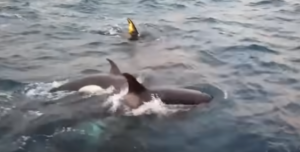A killer whale is hard to miss, and yet we did—for decades. Now scientists have discovered what could be a new species of killer whale thriving in a very inhospitable part of the world, Phys.org reports.
Dubbed Type D, the whales were first recorded in 1955 when 17 stranded on a beach in New Zealand. Their narrow dorsal fins, rounded heads, and small white “eyepatch” made them different, but scientists suspected it was a genetic aberration. Exactly 50 years later, California researcher Bob Pitman saw photos of unusual killer whales near commercial fishing vessels in the southern Indian Ocean. Soon he and his colleagues spotted six more sightings amid Antarctic tourist photos.
With Chilean fishermen complaining that killer whales stole toothfish from their lines, Pitman gathered a research team at Cape Horn in 2018. They waited out eight days of howling winds before launching into a quiet spell. “The sun came up in the morning at 5:50,” Pitman tells NPR. “We had type D killer whales swimming around our boat.” His wife, biologist and team member Lisa Ballance, searched for words: “I can’t even … it was thrilling for all of us,” she says. “It’s like seeing a dinosaur or something.” A harmless dart fired into a whale will determine whether it’s a new species or just a subtype. As Phys.org puts it, the find serves “as a reminder of how little we know about life in our oceans.”
Ask me anything
Explore related questions





